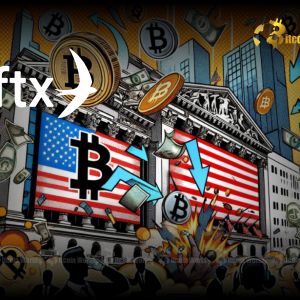Breaking: U.S. Spot Ethereum ETFs Secure $31.8M Inflows, Fueling Optimism
8 min read
BitcoinWorld Breaking: U.S. Spot Ethereum ETFs Secure $31.8M Inflows, Fueling Optimism A wave of optimism is sweeping through the digital asset landscape as U.S. Spot Ethereum ETFs continue to demonstrate remarkable strength. On June 30, these groundbreaking investment vehicles recorded a substantial combined net inflow of $31.8 million, marking the second consecutive day of significant capital injection. This consistent flow of funds underscores a rapidly maturing market and growing confidence from traditional finance in Ethereum, the powerhouse blockchain underpinning a vast decentralized ecosystem. What Do These U.S. Spot Ethereum ETFs Inflows Truly Signify? The recent surge of $31.8 million into U.S. Spot Ethereum ETFs is far more than just a fleeting statistic; it represents a pivotal moment in the integration of cryptocurrencies into mainstream finance. After years of anticipation, debate, and a complex regulatory journey, the official launch of these ETFs has finally opened a direct, regulated gateway for institutional and retail investors alike to gain exposure to Ethereum. Unlike direct cryptocurrency purchases, ETFs offer the familiarity and oversight of traditional brokerage accounts, appealing to a broader spectrum of investors. Data from Farside Investors highlights the key players driving these impressive inflows: Fidelity’s FETH: Leading the pack with a commanding $25.7 million in net inflows. This substantial figure reflects Fidelity’s aggressive push into the digital asset space and its ability to attract significant investor capital. BlackRock’s ETHA: Following closely with a robust $6.1 million contribution. BlackRock, the world’s largest asset manager, brings unparalleled credibility and a vast network of clients, making their participation a strong bullish signal for the Ethereum ecosystem. While other spot Ethereum ETFs reported no change in holdings for the day, the concentrated inflows into products from such financial behemoths underscore a strategic allocation of capital by large-scale investors. This isn’t just retail enthusiasm; it’s a clear signal of institutional conviction in Ethereum’s long-term value proposition and its foundational role in Web3 development. The journey to spot Ethereum ETF approval was arduous, mirroring the path taken by Bitcoin ETFs. This regulatory milestone provides a crucial layer of legitimacy and security, addressing many of the concerns that previously deterred large institutional players. The consistent positive inflows post-launch indicate that this regulatory clarity is now translating directly into actionable investment decisions. How Might This Impact Ethereum Price and Beyond? The immediate and long-term implications of sustained inflows into U.S. Spot Ethereum ETFs on the Ethereum price are a topic of intense speculation among market participants. Fundamentally, increased demand for ETF shares translates directly into increased demand for the underlying ETH, as issuers must acquire Ethereum to back their funds. This direct buying pressure can lead to a reduction in the circulating supply of ETH available on exchanges, which, all else being equal, tends to drive prices upward. Consider the potential mechanisms through which these inflows could influence price: Supply-Demand Dynamics: As more capital enters the ETFs, more ETH is effectively “locked up” within the fund structure, removing it from active trading circulation and creating scarcity. Market Liquidity: The influx of institutional capital can deepen market liquidity, making it easier for larger trades to execute without causing significant price volatility. This can attract even more sophisticated investors. Positive Feedback Loop: Consistent inflows and rising prices can create a self-reinforcing cycle, drawing in more investors who perceive Ethereum as a growth asset with increasing institutional validation. Arbitrage Opportunities: Professional market makers play a crucial role, ensuring the ETF price closely tracks the underlying Ethereum price. Their activities contribute to market efficiency and can further drive demand for ETH. Beyond immediate price action, the presence of these ETFs fosters greater price stability over time. Institutional capital often represents a more “patient” form of investment, less prone to the rapid speculative swings often seen in retail-dominated markets. This could contribute to a more mature and less volatile trading environment for Ethereum in the long run. However, it is vital to acknowledge that the Ethereum price is influenced by a confluence of factors. Macroeconomic conditions, such as inflation rates and central bank policies, global regulatory shifts, and significant developments within the broader blockchain ecosystem (e.g., successful network upgrades like Dencun, or unexpected technical challenges) all play a role. While ETF inflows are a powerful bullish catalyst, they operate within a complex and interconnected financial landscape. The Growing Tide of Institutional Adoption and Crypto Market Trends The consistent positive flows into U.S. Spot Ethereum ETFs are not an isolated event; they are a clear manifestation of a broader, accelerating trend of institutional adoption across the entire cryptocurrency space. For many years, the crypto market was characterized by its grassroots, retail-driven nature, often viewed with skepticism by traditional finance. Now, we are witnessing a profound transformation. Why is institutional engagement so transformative for overall crypto market trends ? Validation and Trust: When major financial institutions like BlackRock, Fidelity, and others enter the crypto arena with regulated products, it signals to a vast pool of traditional investors that cryptocurrencies are legitimate, viable, and here to stay. This validation builds trust and reduces perceived risks. Unlocking Vast Capital: Institutions manage trillions of dollars in assets. Even a small percentage allocation from these funds can translate into hundreds of billions, potentially trillions, of dollars flowing into the crypto ecosystem. This scale of capital dwarfs what individual retail investors can collectively provide. Infrastructure Maturation: Institutional demand necessitates robust, secure, and compliant infrastructure. This drives innovation and investment in areas such as institutional-grade custody solutions, sophisticated trading platforms, enhanced cybersecurity measures, and comprehensive risk management frameworks, benefiting the entire industry. Regulatory Progress: The very process of launching and operating regulated investment products like spot ETFs forces regulators to engage, understand, and ultimately provide clearer guidelines. This regulatory clarity is crucial for fostering a stable and predictable market environment, which in turn attracts more institutional players. Diversification Strategy: As traditional asset classes face new challenges, institutions are increasingly looking for uncorrelated assets to diversify portfolios. Cryptocurrencies, with their unique risk-reward profiles, are becoming attractive candidates for this purpose. This escalating institutional adoption suggests that cryptocurrencies, particularly established assets like Ethereum, are transitioning from purely speculative ventures to recognized components of diversified investment portfolios. This paradigm shift is reshaping the fundamental structure and perception of the digital asset market. Analyzing ETF Market Performance: What Lies Ahead? Closely monitoring the ongoing ETF market performance of these newly launched U.S. Spot Ethereum ETFs will be paramount in understanding the trajectory of institutional interest and its impact on Ethereum. The initial inflows are certainly encouraging, but sustained interest and growth in Assets Under Management (AUM) are crucial indicators of long-term success and market maturity. Key metrics that market participants and analysts will be closely watching include: Daily Net Inflows/Outflows: This provides a real-time pulse of investor sentiment and demand. Consistent positive inflows are a strong bullish signal. Assets Under Management (AUM): The total value of assets held by the ETFs. A growing AUM signifies increasing investor confidence and the overall scale of capital being allocated to Ethereum via these vehicles. Trading Volume: High trading volume indicates healthy market activity and liquidity for the ETF shares themselves, making it easier for investors to enter and exit positions. Premium/Discount to Net Asset Value (NAV): While spot ETFs are designed to track the underlying asset’s price closely, minor premiums or discounts can sometimes emerge, reflecting supply/demand imbalances for the ETF shares. Consistent tracking is a sign of an efficient market. Competitive Landscape: How do different Ethereum ETFs perform against each other? The competition among issuers like Fidelity, BlackRock, VanEck, Grayscale, and others will likely drive innovation in terms of fees, liquidity, and investor services. The success of these Ethereum ETFs could also serve as a blueprint for the approval and launch of other single-asset crypto ETFs, or even multi-asset crypto funds, further integrating digital assets into the existing financial framework. This incremental, yet profoundly significant, integration is a cornerstone of the evolving global financial landscape, hinting at a future where digital assets are a standard part of investment portfolios. Are There Any Challenges or Potential Headwinds to Consider? While the advent of U.S. Spot Ethereum ETFs marks a significant bullish catalyst, it is imperative for investors to approach the market with a balanced perspective, acknowledging potential challenges and headwinds. The broader macroeconomic environment remains a significant factor. Decisions by central banks regarding interest rates, inflationary pressures, and global economic growth forecasts can all influence investor appetite for risk assets like cryptocurrencies. Regulatory dynamics, although currently favorable for spot Ethereum ETFs, are always subject to change. Future regulatory shifts, either domestically or internationally, could introduce new complexities or impose restrictions that impact the market. Geopolitical events, such as conflicts or major political instabilities, can also trigger risk-off sentiment across global markets, affecting crypto assets. Furthermore, the inherent volatility of the crypto market trends means that even with increased institutional backing, significant price fluctuations are to be expected. Ethereum, despite its robust network, is not immune to these swings. Technological risks specific to the Ethereum ecosystem, such as potential network congestion, security vulnerabilities (though rare, they are a concern), or challenges with future upgrades, could also influence investor sentiment and capital flows. Lastly, competition from other Layer 1 blockchains and emerging decentralized finance (DeFi) ecosystems could present alternative investment opportunities, potentially diverting some capital that might otherwise flow into Ethereum. Despite these considerations, the fundamental shift towards institutional adoption and the regulated nature of these ETFs provide a strong foundation and a clear path for sustained growth, indicating a maturing market that is better equipped to handle such pressures. Conclusion: A New Era Dawns for Ethereum Investment The consistent and significant net inflows into U.S. Spot Ethereum ETFs , notably the $31.8 million recorded on June 30, unequivocally signal a new chapter for Ethereum and the broader digital asset economy. Led by financial powerhouses like Fidelity and BlackRock, these capital injections underscore the accelerating momentum of institutional adoption and the growing recognition of Ethereum not just as a technological innovation, but as a legitimate and valuable asset class worthy of mainstream investment. While the immediate impact on the Ethereum price will continue to be influenced by the intricate interplay of market forces, the long-term implications are overwhelmingly positive. These ETFs democratize access for traditional investors, significantly enhance market liquidity, and contribute to the overall maturation and legitimization of crypto market trends . As we diligently monitor the ongoing ETF market performance , it is abundantly clear that the era of mainstream Ethereum investment is not just on the horizon—it has truly arrived, offering unprecedented opportunities and reshaping the future of finance for both seasoned investors and newcomers alike. To learn more about the latest crypto market trends, explore our article on key developments shaping Ethereum institutional adoption. This post Breaking: U.S. Spot Ethereum ETFs Secure $31.8M Inflows, Fueling Optimism first appeared on BitcoinWorld and is written by Editorial Team

Source: Bitcoin World



